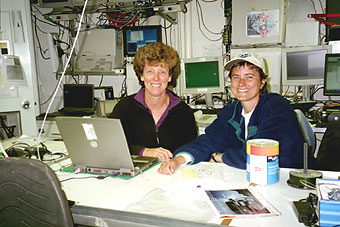

 | |||||||
|
|
Journals 2005/2006Maureen Barrett
September 4, 2005 We ended the day with a sighting of the largest animal on Earth - the blue whale. I was on the bridge when the call came in from the flying bridge asking for a change in course and speed. Officer Paul Kemp made the adjustments to position the Jordan close to the whale. We could easily track the blue whale's position when it remained close to the surface because it appeared an aquamarine color under the water. At one point, the whale was in a trough between two waves, and I could see the entire length of its body. It was huge! It had to be over 80 feet long! It was not until this sighting that I finally grasped the true size of this magnificent animal. What is even more amazing is that these giants feed on some the smallest organisms in the sea. Their diet is made up of copepods, krill and small fish. Annie Douglas was able to get photos of the dorsal fin from both the left and right side of the whale. What a fabulous way to end the day. We also had at least six fin whale sightings today. It is not a high priority to photograph or biopsy these whales, and fin whales are also hard to approach. We did go off effort when it was necessary to get a positive id, but then we returned to our trackline to get right back on effort. If it was up to me, I would be chasing down every cetacean to get a closer look! Even though I have been at sea for 15 days and have seen multiple whales almost every day, I have not had my fill of cetaceans. I am still amazed with each sighting and feel a little heartbroken when we have to leave it behind. That is when I have to remind myself of the priorities of the study. The CSCAPE 2005 cruise has several objectives:
Chief Scientist Susan Chivers' responsibilities include keeping track of these science priorities, coordinating all the scientific activities, and determining the tracklines for the day. Susan has worked for NOAA's Southwest Fisheries for 23 years, and gets out to sea once a year. She started with the organization as a computer programmer and soon after was analyzing data for the tuna/dolphin fisheries. Her work today includes the study of the small dolphin species: harbor porpoise, spotted dolphin, spinners, and common dolphins. Susan's study focuses on the population structure and life history of these marine mammals.
The short-beaked common dolphin biopsies that we obtained on this trip will be used for Susan's population structure study. Susan has been working on this study for about two years. Over the past decade, the lab has obtained about 300 samples from short-beaked common dolphins. From analyzing the DNA, Susan has determined that there are several populations of common dolphins off the coast of California. Each population (southern population, central/northern population, and an off-shore population) is associated with a different body of water with each body of water varying in physical characteristics such as temperature, salinity, and dissolved oxygen. This is a great example of why it is important to characterize the ecosystem through both physical and biological sampling. |
||||||
